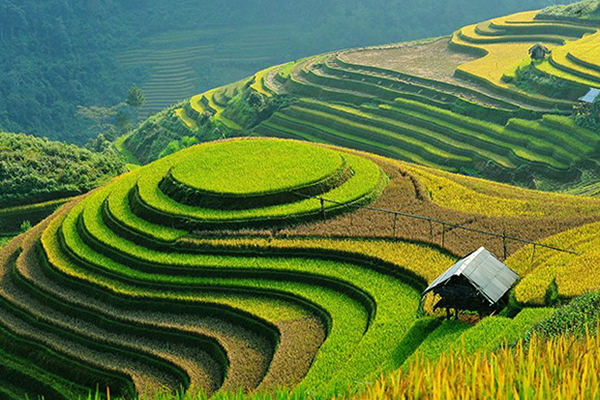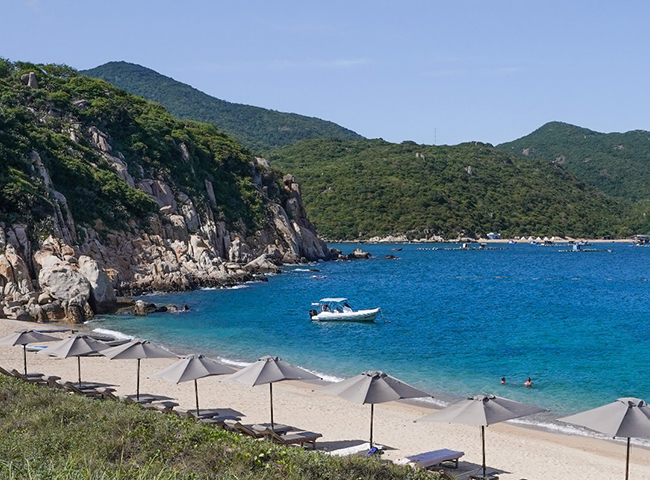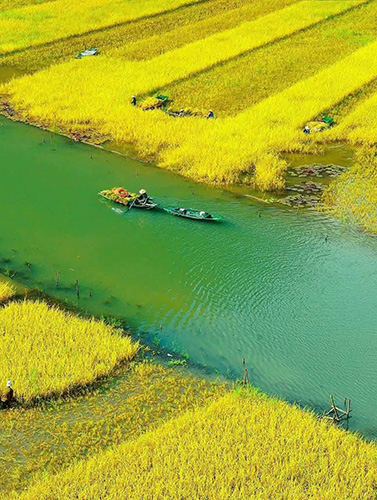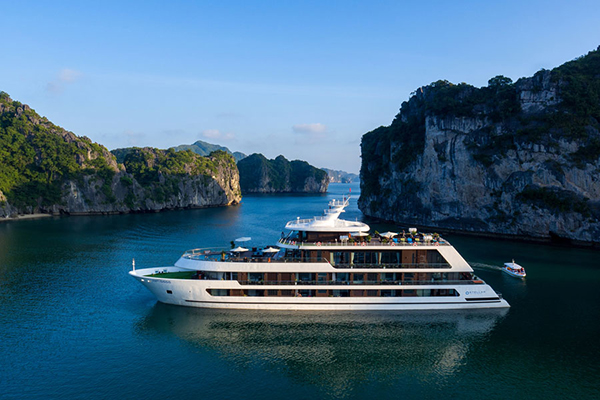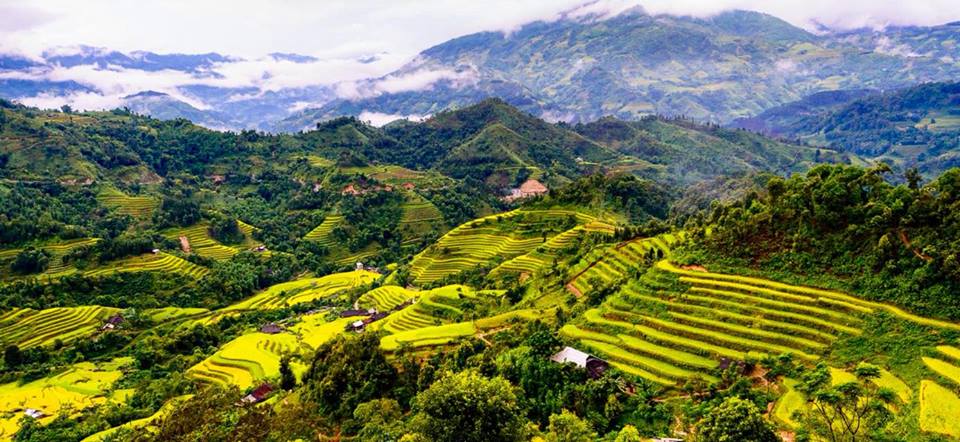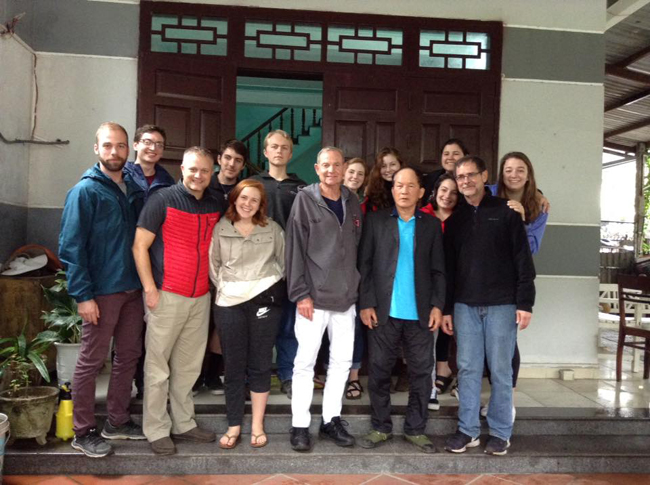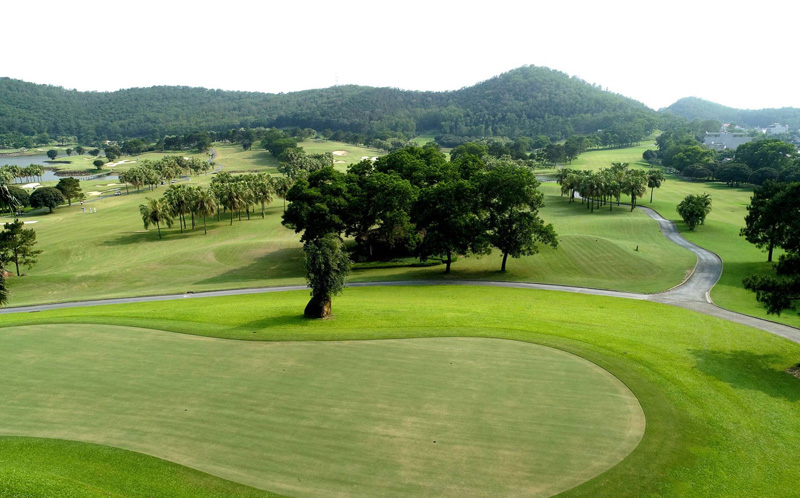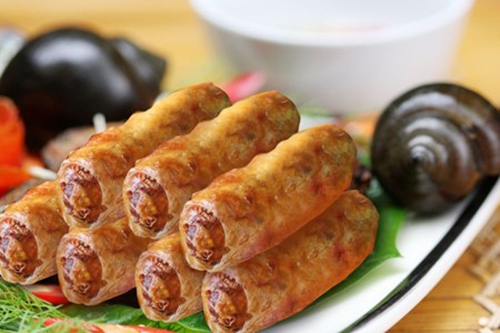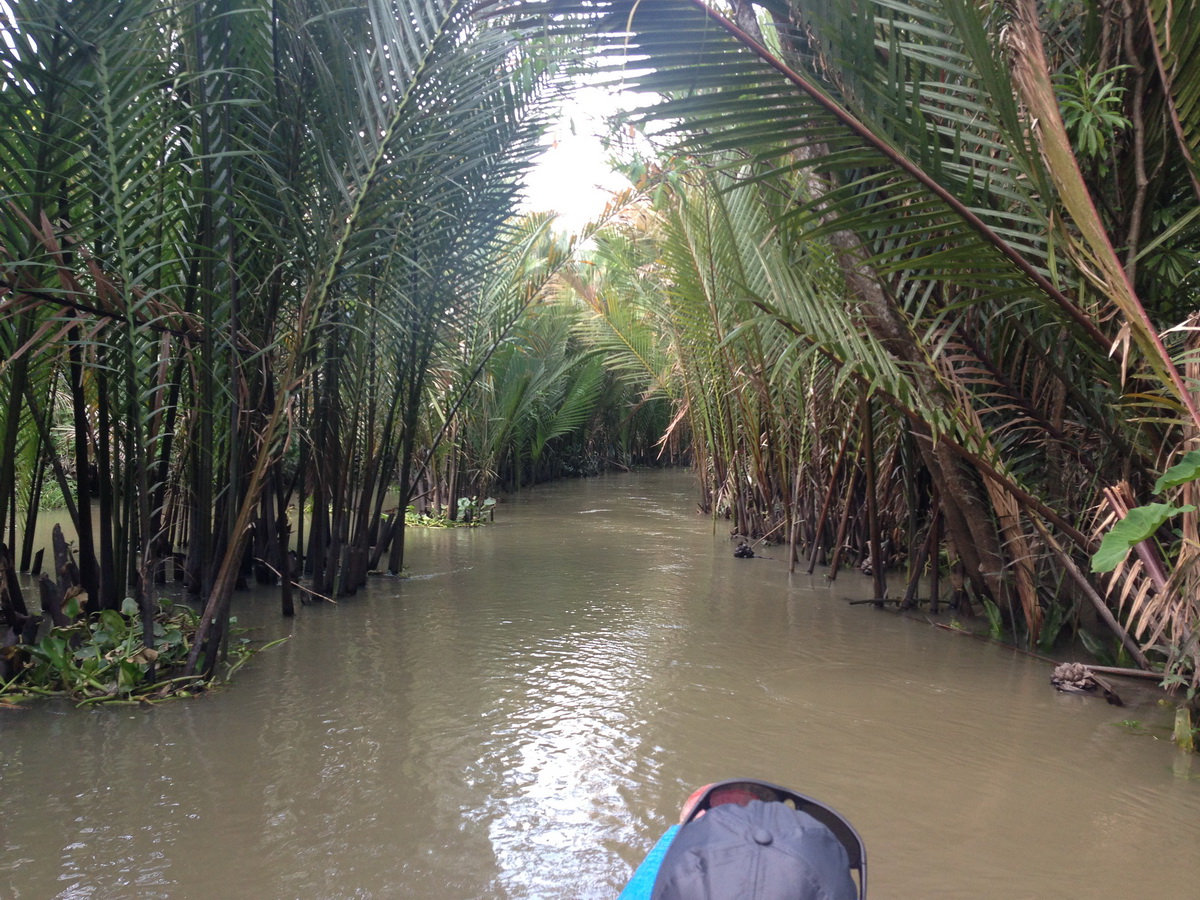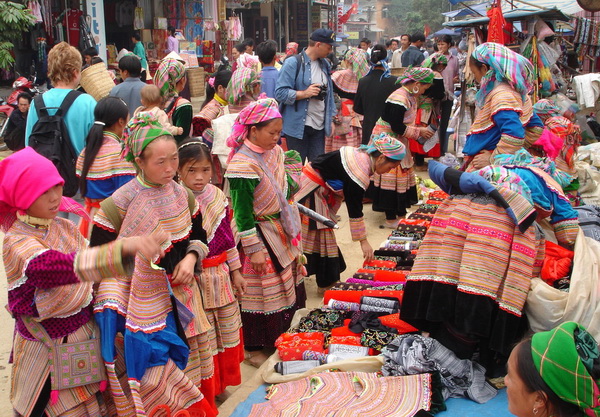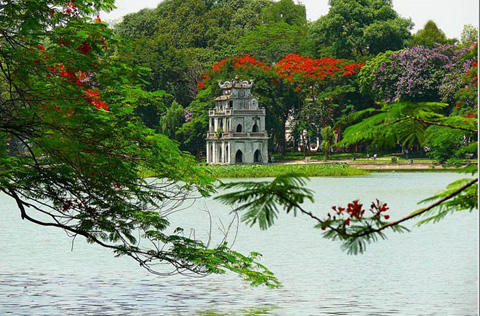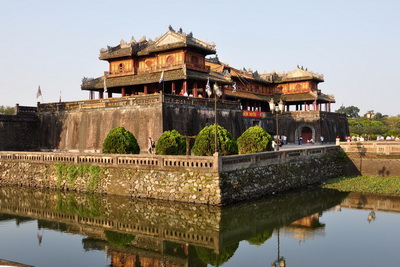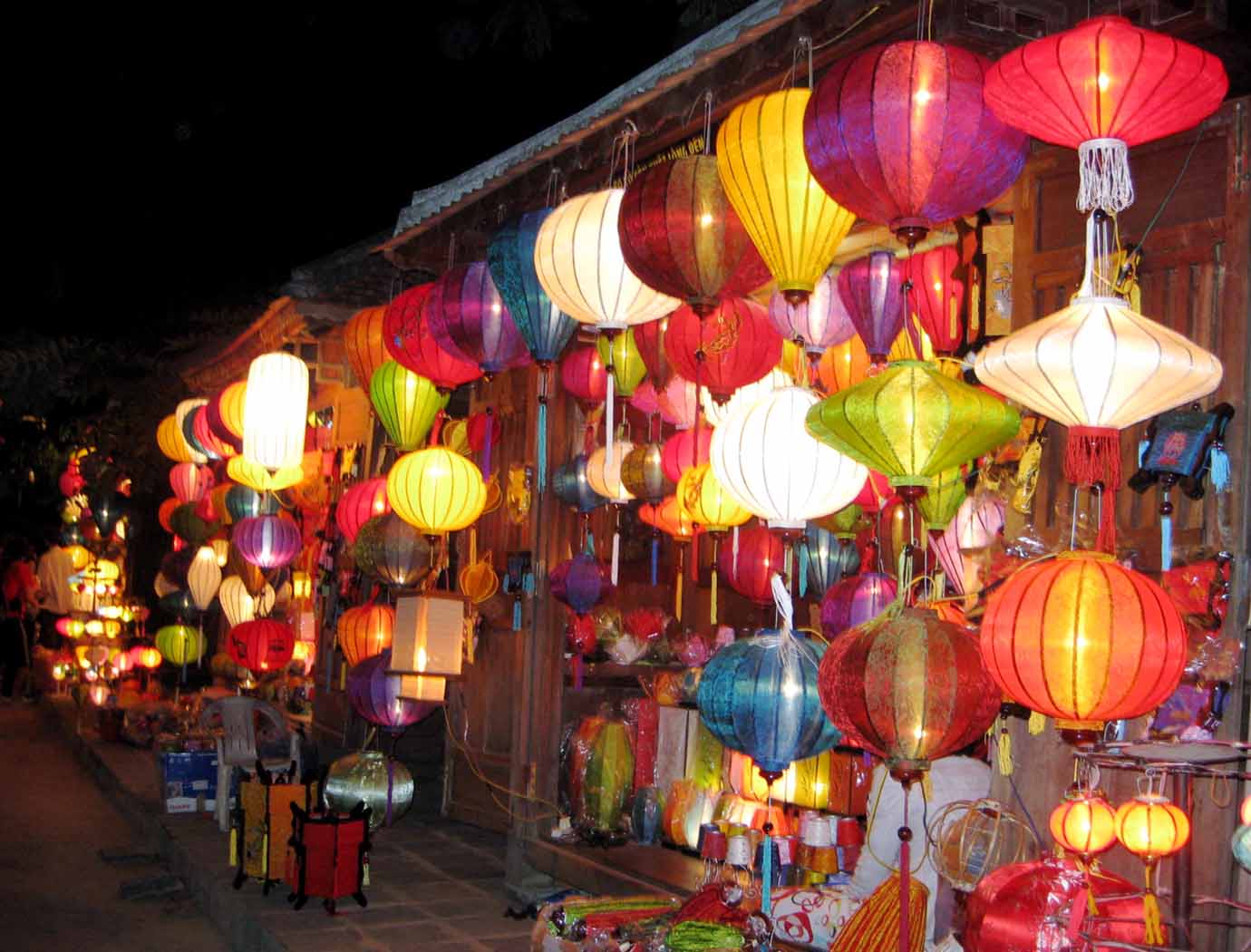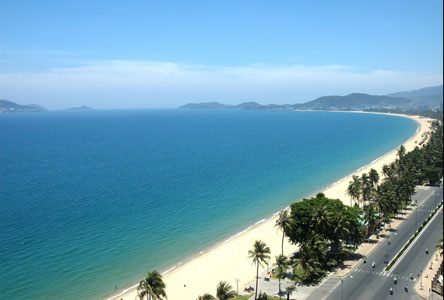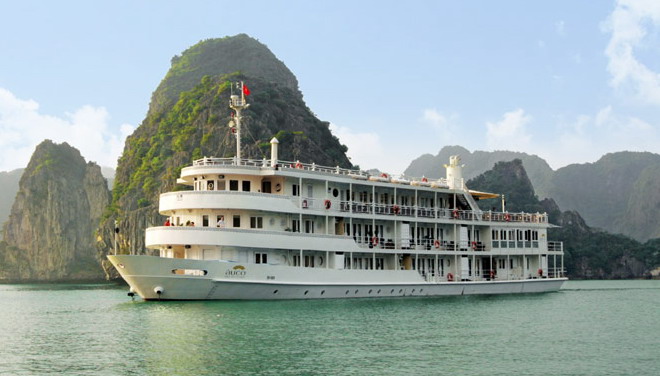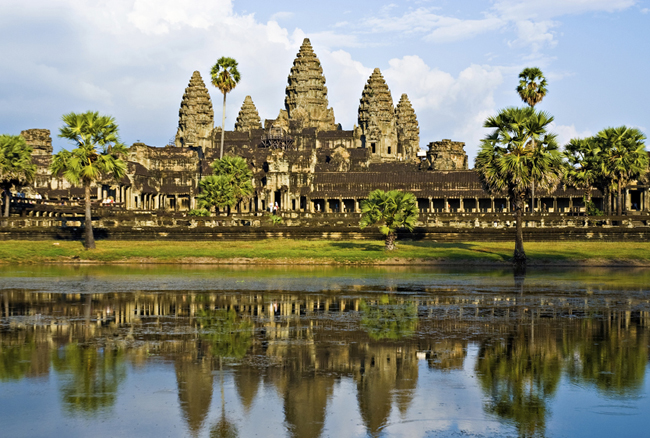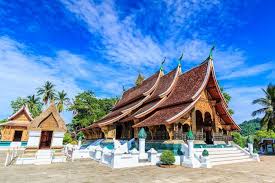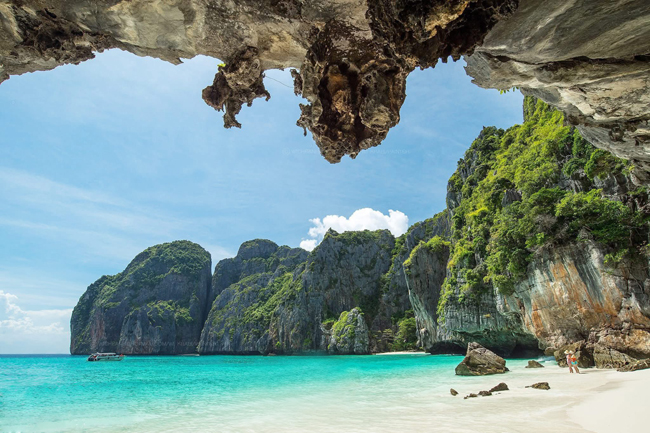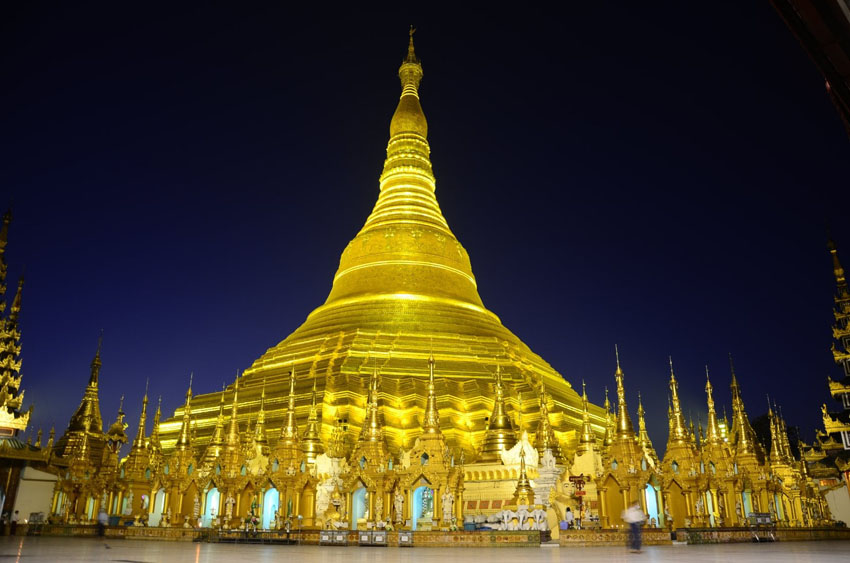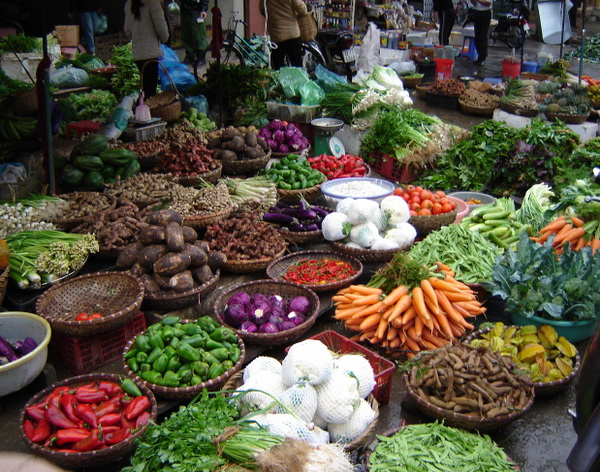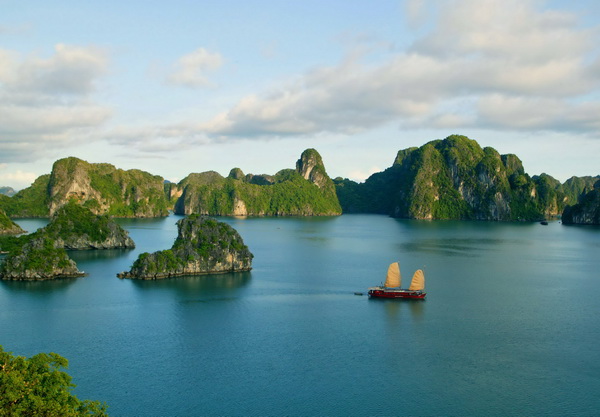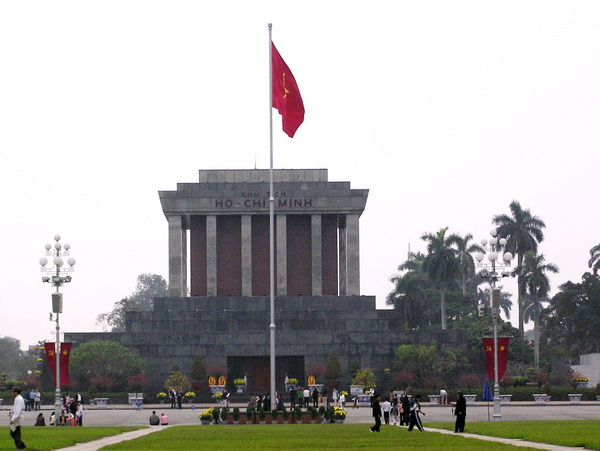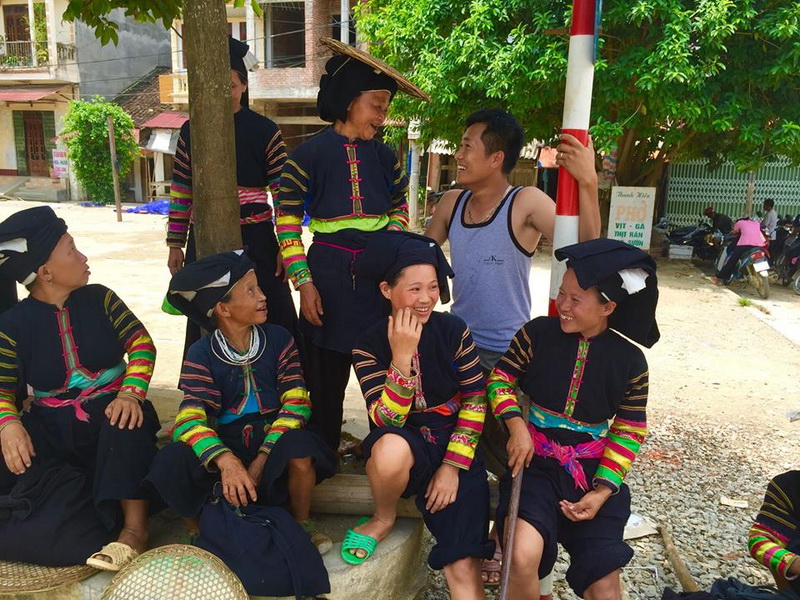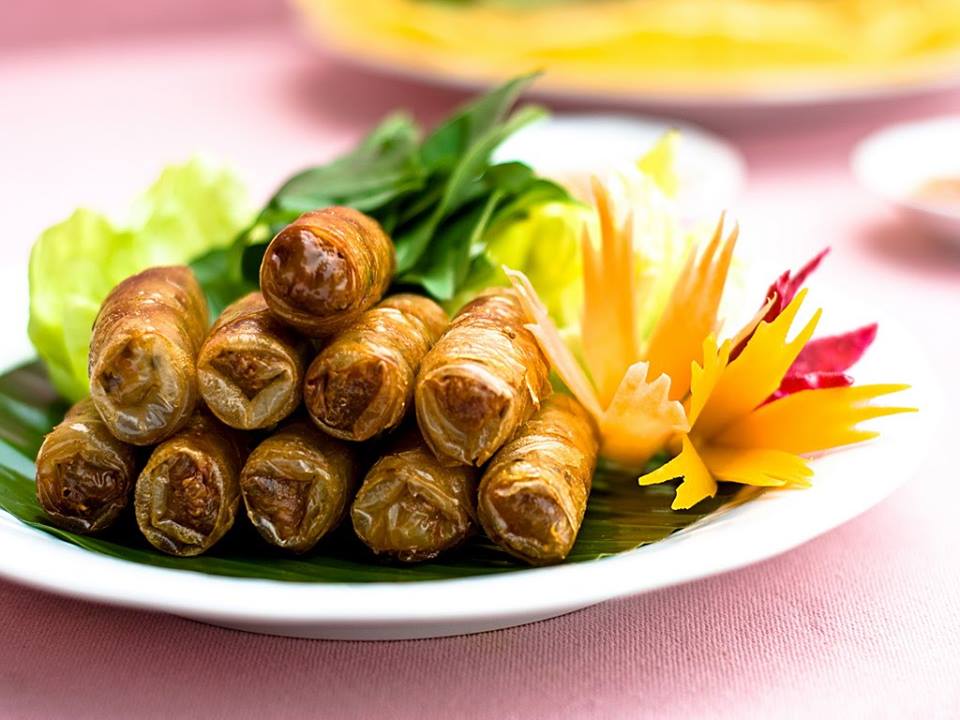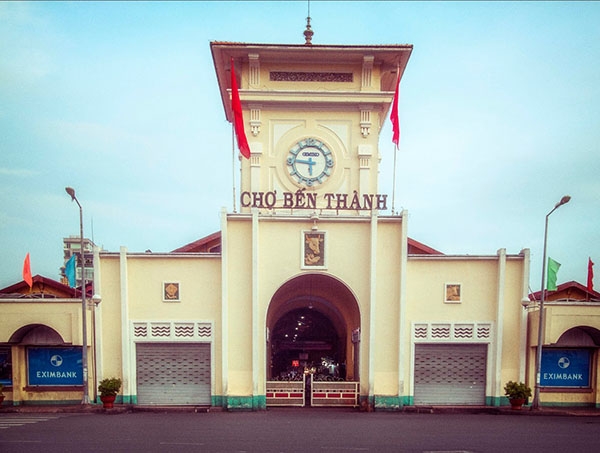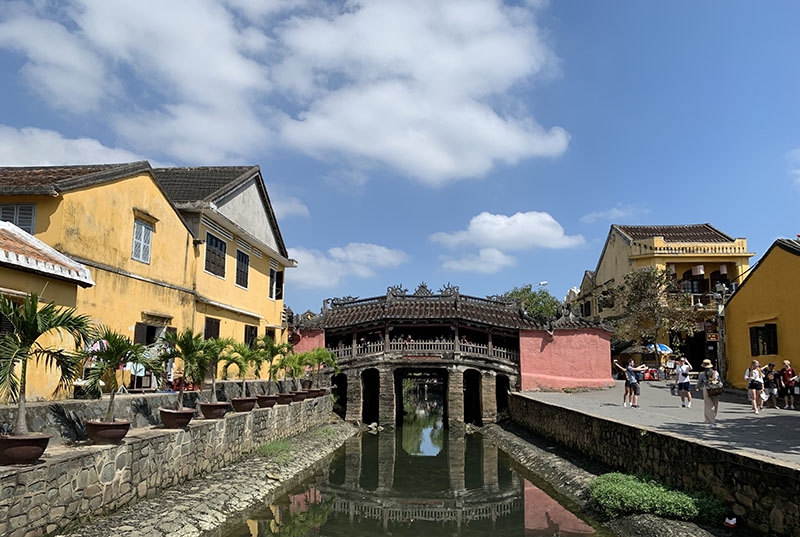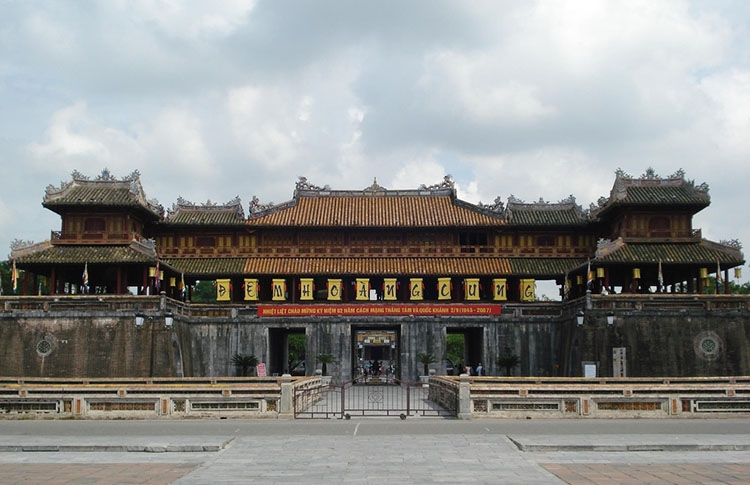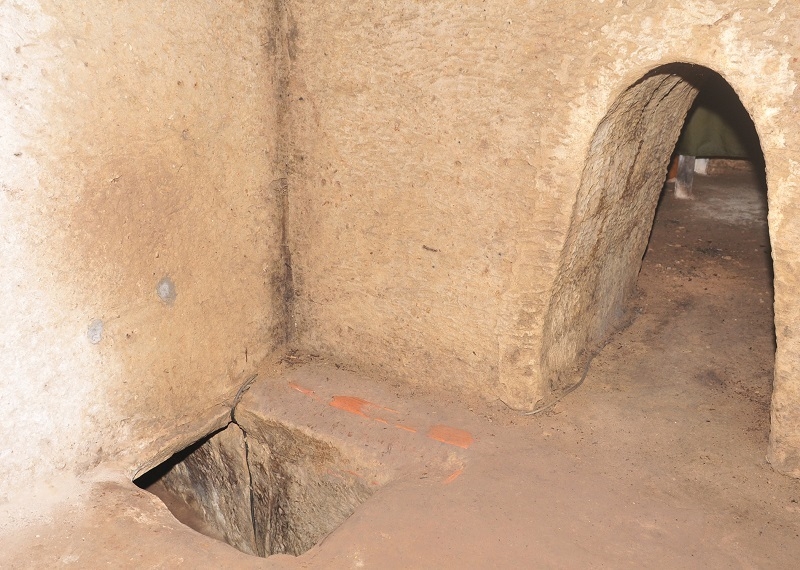Temple of Literature
Temple of Literature or Van Mieu Quoc Tu Giam is a temple dedicated to Confucius in Hanoi Capital, Vietnam. The temple also hosts the Imperial Academy, Vietnam's first national university. The temple was built in 1070 by Emperor Ly Thanh Tong. It is one of several temples in Vietnam which is dedicated to Confucius, sages and scholars. The temple is located to the south of the Imperial Citadel of Thang Long. Nowadays, It’s surrounded by Four Streets : Quoc Tu Giam Street at the Main Gates , Ton Duc Thang Street, Nguyen Thai Hoc Street and Van Mieu street . The temple is featured on the back of the 100,000 Vietnamese Đồng banknote.
HISTORY
The temple was built in 1070 and was reconstructed during the Trần dynasty (1225–1400) and in the subsequent dynasties. For nearly two centuries, despite wars and disasters, the temple has preserved ancient architectural styles of many dynasties as well as precious relics. Major restorations have taken place in 1920, 1954 and 2000.
"In the autumn of the year Canh Tuat, the second year of Than Vu (1070), in the 8th lunar month, during the reign of King Lý Thánh Tông, the Văn Miếu was built. The statues of Confucius, his four best disciples: Yan Hui (Nhan Uyên), Zengzi (Tăng Sâm), Zisi (Tử Tư), and Mencius (Mạnh Tử), as well as the Duke of Zhou (Chu Công), were carved and 72 other statues of Confucian scholars were painted. Ceremonies were dedicated to them in each of the four seasons. The Crown Princes studied here."
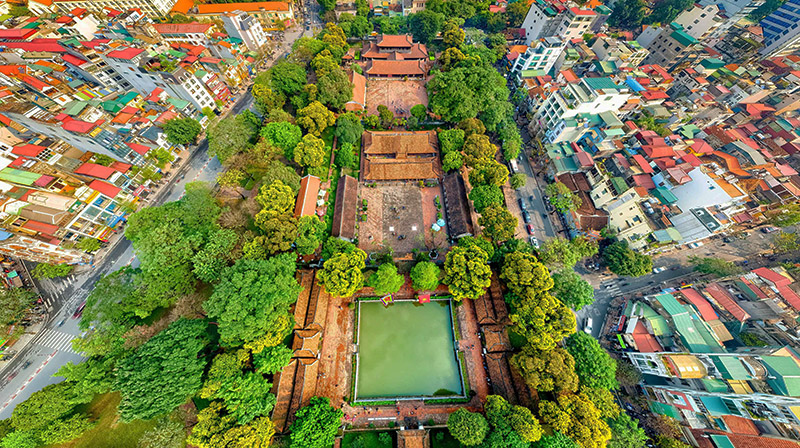
Temple of Literature
In 1076, Vietnam's first university, the "Quốc Tử Giám" or Imperial Academy, was established within the temple during the reign of Lý Nhân Tông to educate Vietnam's bureaucrats, nobles, royalty, and other members of the elite. The university remained open from 1076 to 1779. In 1802, the Nguyễn dynasty's monarchs founded the Huế capital where they established a new imperial academy. The academy at the Hanoi temple lost its prominence and became a school of the Hoài Đức District.
The principals and vice principals of Quốc Tử Giám school in Thăng Long and the Cultural and Educational Development of the Nation.
For more than 700 years, from the 11th century to the end of the 18th century, Quốc Tử Giám school in Thăng Long trained and recommended a number of officials and intellectuals(to the Court), which contributed positively to the development of country. The top officials of Quốc Tử Giám school like Principals and Vice Principals were all talented intellectuals who were selected from a number of prestigious scholars and Court officials.
According to statistics taken from historical documents and nomination certificates, inscriptions of stone steles in some academic localities, among 101 principals and vice principals of Quốc Tử Giám school in Thăng Long (from the 14th century to the 18th century), there are still 5 whose identities have been unidentified. In particular, most of them used to hold important positions in the Court.
As the leaders of the nation’s largest educational centre, they also held important posts in the Court. Principals and vice principals of Quốc Tử Giám school made important contributions to the cultural and educational development of the Nation. They acted as advisors to help kings use the quintessence of Confucianism in order to formulate a policy of training, development and appreciation of the country's talents. Besides, they also directly monitored the implementation of those policies.
The reality shows us that, under the leadership of the Principals and Vice Principals, Quốc Tử Giám school was highly developed and became a model school in the Confucian education system of the country. For more than 7 centuries, since the foundation of Quốc Tử Giám school in 1076, a large number of schools were established from the central to local areas, from Thăng Long citadel to provinces, districts and villages. Therefore, the schools trained thousands of talents who made great contributions in the fields of politics, economics, education, literature, history, geography, math ...
As diplomats, principals and vice principals of the Quoc Tu Giam school were sent to China (under the Ming and Qing dynasties). They managed to use their ability and knowledge to build a flexible diplomatic relationship on the principle of maintaining national independence and sovereignty.
Above all, the Principals and Vice Principals of Quốc Tử Giám School were not only "important figures" who decided the fate of the school over a period of hundreds of years under the Ly, Tran, Le dynasties; moreover, they also played an important role in promoting the overall development of the country's culture and education
ARCHITECTURE
Great Portico of Van Mieu
The Great Portico was built in the early 20th century. The gate was built as a two-tier brick structure with eight roofs and three doors. The central door is large in both height and width, and bears three Chinese characters- “Văn Miếu Môn” (Great Portico of Van Mieu) on the top tier. The two ironwooden doors open up to the inside of the temple and are adorned with two dragons flanking the moon on the top.
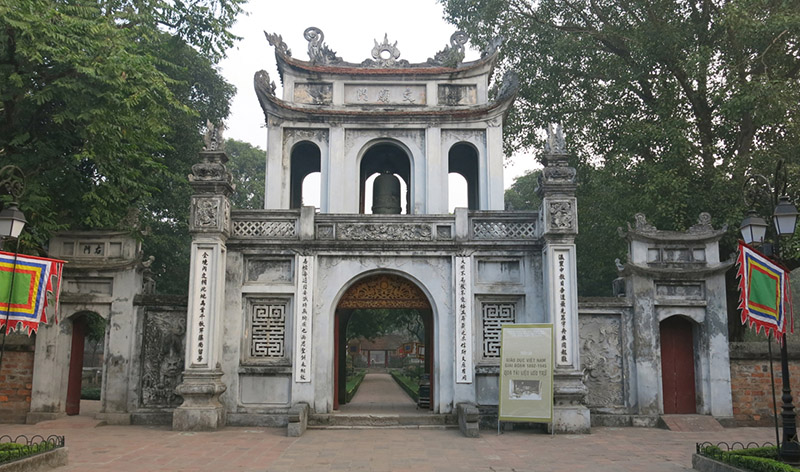
In front of Van Mieu’s Great Portico are two stone dragons in the architectural style of the Le dynasty (15th century) and behind it are another two stone dragons from the Nguyen dynasty (19th century). On the two sides of the Great Portico are parallel sentences in Chinese. There are two Friezes to the right and left of the central arch. One shows an ascending dragon symbolizing endeavour and success in studying and another shows a tiger descending from a mountain symbolizing the strength and power of intellect bringing help to humanity.
“HẠ MÔ Stele at the Temple of Literature
In front of the entrance to the Temple of Literature (Văn Miếu - Quốc Tử Giám), there are two steles located on both sides, engraved with the word “Hạ mã”, which means getting off a horse.
The stele was erected in 1771 by Nguyễn Hoản - the vice principal of Quốc Tử Giám. The stele, which is erected on a pedestal in a small shelter, is very harmonious with its surroundings.
In the past, along with The Four Brick Pillars placed in front of the Temple of Literature, the “Hạ mã” stele is considered an icon horizontally bounding the site. The "Hạ mã" steles were erected to remind passersby, from servants to emperors, to get off the horse and walk at least the distance between the two steles to pay homage to the Saints.
The “Hạ mã” stele is not a place of worship and should be preserved like other artefacts of the Temple of Literature.
One of the distinctive features of traditional Vietnamese environmental planning is the way in which a balance is achieved between fluid water and solid buildings. There has always been a lake in front of the Văn Miếu. The Văn Lake (Literature Lake) in former times was not separated from the Văn Miếu by a busy road, as it is today. In the past the Văn Lake was spacious with Kim Châu islet at the centre. Under the Nguyễn dynasty, a communal hall (Văn Hồ Đình) covered with tiled roofs was built on the islet for literary activities. Confucian scholars used to discuss literature and recite poems in this hall.
Thanh Đat Courtyard and Khue Van Pavilion.
The second courtyard of Van Mieu is Thành Đạt courtyard. There are also three paths in this area, including a central path called Hoàng Đạo running from Đại Trung Gate to Khuê Văn pavilion. The two smaller paths run on each side. One leads to Bí Văn gate and the other to Súc Văn gate. Bí Văn means coherent writing style, Súc Văn means concise content

Khuê Vân Các
In 1805, the Governor of Bắc Thành (Nothern Citadel), Mr. Nguyễn Văn Thành ordered the construction of Khuê Văn Các, meaning “Khuê Constellation Pavilion”, at Văn Miếu in Hà Nội. The pavilion is a symmetrical, simple, and elegant building. Its platform is square and its windows round. The pavilion has double roofs of pipe-shaped tiles. On the pavilion hangs a red board with three golden chinese characters-“Khuê Văn Các”- meaning Khuê Văn Pavilion. According to oriental astronomy, Khuê is the brightest constellation of 28 constellations. Khuê constellation includes 16 small stars that incidentally form the Chinese character Văn (文). That explains why ancient people believed Khuê constellation could moniter the Văn-literature. On the Khuê Văn Các hang many parallel sentences that represent the vitality of knowledge and intelligence.
“Khuê constellation in the sky, as bright as the humanity in life.
Bích river in spring time, as lively as learning for ever”
In 2012, Khuê Văn Các was chosen as the symbol of the Hanoi Capital.
Van Lake and Giam Garden
One of the traditional characteristics of Vietnamese architectural planning is that the environment be in harmony with the trees, water, and other buildings nearby. Temples, communal houses, and pagodas are normally one -story high, shaded by trees, and have a lake at the front of the main entrance gate. Quoc Tu Giam also bears those typical features.
Van Lake covers an area of 12.297 square meters, and in its center is Kim Chau Islet on which was a communal house which used to be a place for Confucian scholars in the Thang Long citadel to meet and recite poems. Nowadays, this house no longer exists.
The Văn Lake and its surrounds were restored by the Nguyễn dynasty in 1883. Later, the lake came under the management of Hanoi’s municipal council. In 1940, the lake was returned to the Văn Miếu. Later, it became overgrown with shrubs and bushes and encroached upon by shops and houses. By 1990 the lake was almost totally hidden from view by recent buildings and a plant nursery.
Because of the Văn Lake’s importance, the Hanoi People’s Committee funded its restoration in 1998. It is now open again to the general public and complements the four pillars and grand entrance to the Văn Miếu. Many important cultural activities take place here, such as a poetry festival and a calligraphy festival in spring.
Along with Van Lake, to the west of Van Mieu is Giam Garden whose many structures and decorations were added later: walls, trees, grass, flowers, walking lanes, and the Octagonal Pavilion in which traditional art performances take place.
Thái Học Courtyard
Thai Hoc courtyard was constructed in 2000 on the former ground of Quoc Tu Giam to celebrate 990th anniversary of the capital Thang Long – Hanoi and to honor the national traditions of culture and education.
The designs of the Thái Học courtyard were based on the traditional architecture in harmony with the surrounding sights of the Temple of Literature.

Thai Hoc Couryard
With an area of 1530m2 out of a total 6150m2, the Thai Hoc courtyard consists of the building in front, building behind, left and right buildings, bell house, drum house and other buildings. The main materials for their construction were ironwood, shoe-like tiles and bricks.
The building in front is used for organizing ceremonies in memory of cultural scholars, scientific and cultural activities.
The building behind consists of two storeys. The ground floor is used for displaying the statue of Director of Quoc Tu Giam Chu Van An to honor him and the exhibits on the history of Van Mieu- Quoc Tu Giam, and on Confucian education in Vietnam. The upper floor is dedicated to three Kings who contributed most to the foundation of Van Mieu – Quoc Tu Giam and to the development of Confucian education in Vietnam.
King Ly Thanh Tong (1023- 1072) who founded the temple in 1070.
King Ly Nhan Tong (1066- 1127) who founded the first National University in 1076.
King Le Thanh Tong (1442- 1497) who ordered the erection of stone stelae of doctor laureates in 1484.
Đai Thanh Sanctuary
Đại Thành Sanctuary consists of nine compartments, the three sides have no windows or doors while the front side of the seven central compartments have wooden doors. The two outermost compartments have no doors but windows with wooden bars in the architectural style of the Later Lê Dynasty. All of the wooden columns in this building were red-lacquered, on the rooftop are two dragons flanking a moon, and the roof is tiled with shoe-shaped tiles.
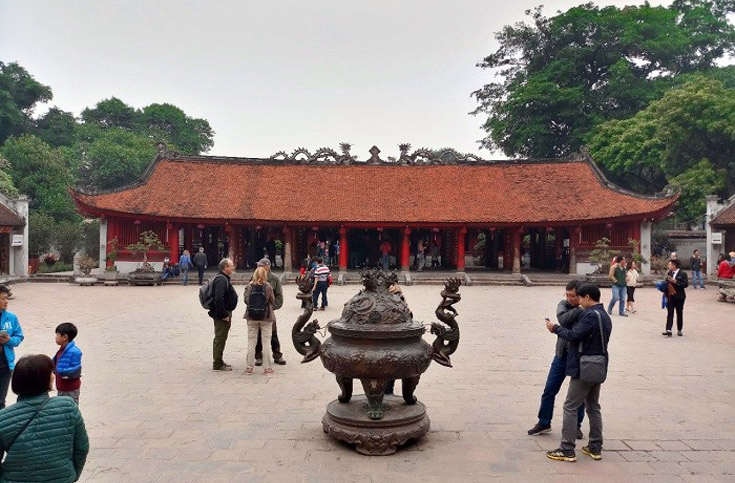
Dai Thanh Sanctuary
Dai Thanh Sanctuary runs parallel with the Great House of Ceremony, and is connected by a small house. This place is used for the worshipping of Confucius, Four most brilliant students of Confucius and Ten Chinese Philosophers.
The central compartment is for worshiping Confucius; his face turns to the South, according to the concept of "Thanhs nhân Nam diện nhi trị”, it means a saint turns his face to the South to rule the nation. Behind the altar is a wooden tablet engraved with the name of Confucius. Confucius, known as Zhong Ni, was born in Zou, Qufu, State of Lu (now in Shandong Province, China) in 551 BC and passed away in 479 BC. He was worshiped in Vietnam since the 11th century as a great thinker and educator.
On both sides of the statue of Confucius are four statues, the statues represent four most brilliant students of Confucius: Yanhui, Zengzi, Zisi, and Mengzi. They made a great contribution to the development of Confucianism.
Dai Thanh Gate
Đại Thành Gate is in the architectural style of the Later Le dynasty (15th -17th centuries). It is a wooden structure with three compartments and a shoe-shaped tiled roof. The doors are decorated with motifs of “dragons in clouds”, depicting the aspiration for a prosperous system of Confucian education. On the platform of Đại Thành Gate are six skillfully-made lions (two stone lions and four wooden) which are used as doorhinges.
To the sides of Đại Thành Gate are two small side gates, Kim Thanh (Golden Sound) and Ngọc Chấn (Jade Vibration), leading to the two building: Left house and Right house.
Behind Đại Thành gate is Đại Bái yard. To the sides of the yard are two houses: Left and Right House, each has nine compartments. Previously, the two houses used to be places for the worshipping of 72 Chinese sages (72 students of Confucius). However, both of them were destroyed in 1946, the two new houses were constructed on the same ground in 1954.
Garden of the Doctors’ Stelae and Thiên Quang Well.
The garden of the Doctors’ Stelae is a significant section of the relic. In the center of the garden is a square well named Thiên Quang Tỉnh or Well of Heavenly Brilliance. The ancient well is surrounded by a brick banister, and has two brick stairs in the East and West. The well is full of pure water all year round.
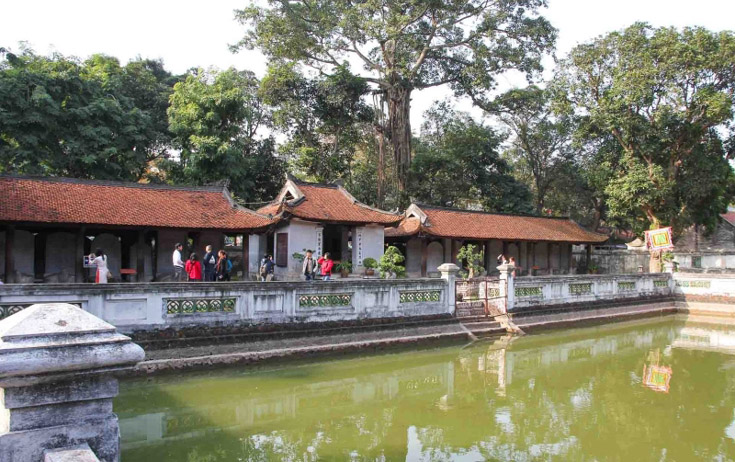
Doctors’ Stelae and Thiên Quang Well
To the sides of the well, to the East and West, are lines of Doctors’ stelae. The first stelae erected in 1484 under King Le Thanh Tong’s Dynasty aimed not only to honor talented people, but also to encourage comtemporary and future generations in education. The stelae were erected over a period of 300 years (1484-1780).
Only 82 stelae remain today, the stelae are engraved with the names and homelands of 1.304 doctors of 82 royal examinations held between 1442 and 1779.
In 1994, eight lines of shelter houses were constructed to protect these stelae. These houses have wooden frames and shoe-shaped tiled roofs. Because they are not very large, so they are in harmony with Khuê Văn Pavilion and Thiên Quang Well, creating a complete architectural scenery in this area.
Nhập Đạo Courtyard and Đại Trung Gate
Pass through the Great Portico to enter the Nhập Đạo Courtyard, or the “Entrance to the Way”. This courtyard is covered with trees and grass and on each side is a pond.
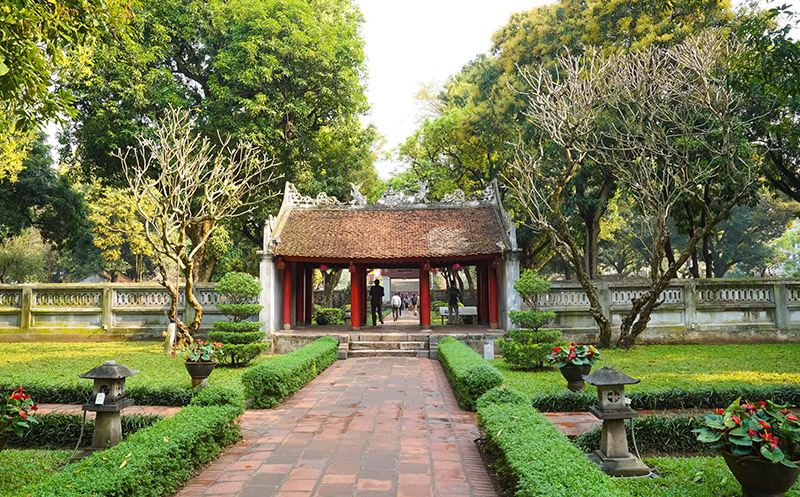
Dai Trung Gate
The central path leads to the Great Middle Gate and the other two side paths lead to two small gates. The name of each gate symbolizes wisdom: Thành Đức (Accomplished Virtue) and Đạt Tài (Attained Talent).
The Great Middle Gate is built in the architectural style of the Later Lê dynasty (15th-17th centuries). It is a wooden construction with three compartments supported by wooden columns and a shoe-shaped tiled roof; on the rooftop are two carps flanking a flask called Móc, the carp and the flask were decorated with pieces of glazed terracotta and porcelain. The ground of the gate was laid with bricks made in Bát Tràng. The gate was set up on a brick platform surrounded by stone and has three steps, making it sizeable and solemn.
HOW TO VISIT
In the summer, Temple of Literature - Quoc Tu Giam is open weekdays from 7:30 am to 17:30 pm.
In the winter, the Temple of Literature - Quoc Tu Giam is open weekdays from 8:00 am to 17:30 pm.
Please visit the ticket and present the ticket at the ticket counter
Please follow the rules when visiting
Address: 58 Quoc Tu Giam, Van Mieu, Dong Da, Hanoi , about 2 kms from Hoan Kiem Lake and Hanoi Old Quarter, 700ms from Ho Chi Minh Mausoleum Complex
It's easy to get here by walk, Cyclo or taxi from your hotel. You can visit this place by yourselves of book a Hanoi City Tour with A good local travel Agency in Hanoi
The temple was built in 1070 and was reconstructed during the Trần dynasty (1225–1400) and in the subsequent dynasties. For nearly two centuries, despite wars and disasters, the temple has preserved ancient architectural styles of many dynasties as well as precious relics. Major restorations have taken place in 1920, 1954 and 2000.
"In the autumn of the year Canh Tuat, the second year of Than Vu (1070), in the 8th lunar month, during the reign of King Lý Thánh Tông, the Văn Miếu was built. The statues of Confucius, his four best disciples: Yan Hui (Nhan Uyên), Zengzi (Tăng Sâm), Zisi (Tử Tư), and Mencius (Mạnh Tử), as well as the Duke of Zhou (Chu Công), were carved and 72 other statues of Confucian scholars were painted. Ceremonies were dedicated to them in each of the four seasons. The Crown Princes studied here."

Temple of Literature
In 1076, Vietnam's first university, the "Quốc Tử Giám" or Imperial Academy, was established within the temple during the reign of Lý Nhân Tông to educate Vietnam's bureaucrats, nobles, royalty, and other members of the elite. The university remained open from 1076 to 1779. In 1802, the Nguyễn dynasty's monarchs founded the Huế capital where they established a new imperial academy. The academy at the Hanoi temple lost its prominence and became a school of the Hoài Đức District.
The principals and vice principals of Quốc Tử Giám school in Thăng Long and the Cultural and Educational Development of the Nation.
For more than 700 years, from the 11th century to the end of the 18th century, Quốc Tử Giám school in Thăng Long trained and recommended a number of officials and intellectuals(to the Court), which contributed positively to the development of country. The top officials of Quốc Tử Giám school like Principals and Vice Principals were all talented intellectuals who were selected from a number of prestigious scholars and Court officials.
According to statistics taken from historical documents and nomination certificates, inscriptions of stone steles in some academic localities, among 101 principals and vice principals of Quốc Tử Giám school in Thăng Long (from the 14th century to the 18th century), there are still 5 whose identities have been unidentified. In particular, most of them used to hold important positions in the Court.
As the leaders of the nation’s largest educational centre, they also held important posts in the Court. Principals and vice principals of Quốc Tử Giám school made important contributions to the cultural and educational development of the Nation. They acted as advisors to help kings use the quintessence of Confucianism in order to formulate a policy of training, development and appreciation of the country's talents. Besides, they also directly monitored the implementation of those policies.
The reality shows us that, under the leadership of the Principals and Vice Principals, Quốc Tử Giám school was highly developed and became a model school in the Confucian education system of the country. For more than 7 centuries, since the foundation of Quốc Tử Giám school in 1076, a large number of schools were established from the central to local areas, from Thăng Long citadel to provinces, districts and villages. Therefore, the schools trained thousands of talents who made great contributions in the fields of politics, economics, education, literature, history, geography, math ...
As diplomats, principals and vice principals of the Quoc Tu Giam school were sent to China (under the Ming and Qing dynasties). They managed to use their ability and knowledge to build a flexible diplomatic relationship on the principle of maintaining national independence and sovereignty.
Above all, the Principals and Vice Principals of Quốc Tử Giám School were not only "important figures" who decided the fate of the school over a period of hundreds of years under the Ly, Tran, Le dynasties; moreover, they also played an important role in promoting the overall development of the country's culture and education
ARCHITECTURE
Great Portico of Van Mieu
The Great Portico was built in the early 20th century. The gate was built as a two-tier brick structure with eight roofs and three doors. The central door is large in both height and width, and bears three Chinese characters- “Văn Miếu Môn” (Great Portico of Van Mieu) on the top tier. The two ironwooden doors open up to the inside of the temple and are adorned with two dragons flanking the moon on the top.

In front of Van Mieu’s Great Portico are two stone dragons in the architectural style of the Le dynasty (15th century) and behind it are another two stone dragons from the Nguyen dynasty (19th century). On the two sides of the Great Portico are parallel sentences in Chinese. There are two Friezes to the right and left of the central arch. One shows an ascending dragon symbolizing endeavour and success in studying and another shows a tiger descending from a mountain symbolizing the strength and power of intellect bringing help to humanity.
“HẠ MÔ Stele at the Temple of Literature
In front of the entrance to the Temple of Literature (Văn Miếu - Quốc Tử Giám), there are two steles located on both sides, engraved with the word “Hạ mã”, which means getting off a horse.
The stele was erected in 1771 by Nguyễn Hoản - the vice principal of Quốc Tử Giám. The stele, which is erected on a pedestal in a small shelter, is very harmonious with its surroundings.
In the past, along with The Four Brick Pillars placed in front of the Temple of Literature, the “Hạ mã” stele is considered an icon horizontally bounding the site. The "Hạ mã" steles were erected to remind passersby, from servants to emperors, to get off the horse and walk at least the distance between the two steles to pay homage to the Saints.
The “Hạ mã” stele is not a place of worship and should be preserved like other artefacts of the Temple of Literature.
One of the distinctive features of traditional Vietnamese environmental planning is the way in which a balance is achieved between fluid water and solid buildings. There has always been a lake in front of the Văn Miếu. The Văn Lake (Literature Lake) in former times was not separated from the Văn Miếu by a busy road, as it is today. In the past the Văn Lake was spacious with Kim Châu islet at the centre. Under the Nguyễn dynasty, a communal hall (Văn Hồ Đình) covered with tiled roofs was built on the islet for literary activities. Confucian scholars used to discuss literature and recite poems in this hall.
Thanh Đat Courtyard and Khue Van Pavilion.
The second courtyard of Van Mieu is Thành Đạt courtyard. There are also three paths in this area, including a central path called Hoàng Đạo running from Đại Trung Gate to Khuê Văn pavilion. The two smaller paths run on each side. One leads to Bí Văn gate and the other to Súc Văn gate. Bí Văn means coherent writing style, Súc Văn means concise content

Khuê Vân Các
In 1805, the Governor of Bắc Thành (Nothern Citadel), Mr. Nguyễn Văn Thành ordered the construction of Khuê Văn Các, meaning “Khuê Constellation Pavilion”, at Văn Miếu in Hà Nội. The pavilion is a symmetrical, simple, and elegant building. Its platform is square and its windows round. The pavilion has double roofs of pipe-shaped tiles. On the pavilion hangs a red board with three golden chinese characters-“Khuê Văn Các”- meaning Khuê Văn Pavilion. According to oriental astronomy, Khuê is the brightest constellation of 28 constellations. Khuê constellation includes 16 small stars that incidentally form the Chinese character Văn (文). That explains why ancient people believed Khuê constellation could moniter the Văn-literature. On the Khuê Văn Các hang many parallel sentences that represent the vitality of knowledge and intelligence.
“Khuê constellation in the sky, as bright as the humanity in life.
Bích river in spring time, as lively as learning for ever”
In 2012, Khuê Văn Các was chosen as the symbol of the Hanoi Capital.
Van Lake and Giam Garden
One of the traditional characteristics of Vietnamese architectural planning is that the environment be in harmony with the trees, water, and other buildings nearby. Temples, communal houses, and pagodas are normally one -story high, shaded by trees, and have a lake at the front of the main entrance gate. Quoc Tu Giam also bears those typical features.
Van Lake covers an area of 12.297 square meters, and in its center is Kim Chau Islet on which was a communal house which used to be a place for Confucian scholars in the Thang Long citadel to meet and recite poems. Nowadays, this house no longer exists.
The Văn Lake and its surrounds were restored by the Nguyễn dynasty in 1883. Later, the lake came under the management of Hanoi’s municipal council. In 1940, the lake was returned to the Văn Miếu. Later, it became overgrown with shrubs and bushes and encroached upon by shops and houses. By 1990 the lake was almost totally hidden from view by recent buildings and a plant nursery.
Because of the Văn Lake’s importance, the Hanoi People’s Committee funded its restoration in 1998. It is now open again to the general public and complements the four pillars and grand entrance to the Văn Miếu. Many important cultural activities take place here, such as a poetry festival and a calligraphy festival in spring.
Along with Van Lake, to the west of Van Mieu is Giam Garden whose many structures and decorations were added later: walls, trees, grass, flowers, walking lanes, and the Octagonal Pavilion in which traditional art performances take place.
Thái Học Courtyard
Thai Hoc courtyard was constructed in 2000 on the former ground of Quoc Tu Giam to celebrate 990th anniversary of the capital Thang Long – Hanoi and to honor the national traditions of culture and education.
The designs of the Thái Học courtyard were based on the traditional architecture in harmony with the surrounding sights of the Temple of Literature.

Thai Hoc Couryard
With an area of 1530m2 out of a total 6150m2, the Thai Hoc courtyard consists of the building in front, building behind, left and right buildings, bell house, drum house and other buildings. The main materials for their construction were ironwood, shoe-like tiles and bricks.
The building in front is used for organizing ceremonies in memory of cultural scholars, scientific and cultural activities.
The building behind consists of two storeys. The ground floor is used for displaying the statue of Director of Quoc Tu Giam Chu Van An to honor him and the exhibits on the history of Van Mieu- Quoc Tu Giam, and on Confucian education in Vietnam. The upper floor is dedicated to three Kings who contributed most to the foundation of Van Mieu – Quoc Tu Giam and to the development of Confucian education in Vietnam.
King Ly Thanh Tong (1023- 1072) who founded the temple in 1070.
King Ly Nhan Tong (1066- 1127) who founded the first National University in 1076.
King Le Thanh Tong (1442- 1497) who ordered the erection of stone stelae of doctor laureates in 1484.
Đai Thanh Sanctuary
Đại Thành Sanctuary consists of nine compartments, the three sides have no windows or doors while the front side of the seven central compartments have wooden doors. The two outermost compartments have no doors but windows with wooden bars in the architectural style of the Later Lê Dynasty. All of the wooden columns in this building were red-lacquered, on the rooftop are two dragons flanking a moon, and the roof is tiled with shoe-shaped tiles.

Dai Thanh Sanctuary
Dai Thanh Sanctuary runs parallel with the Great House of Ceremony, and is connected by a small house. This place is used for the worshipping of Confucius, Four most brilliant students of Confucius and Ten Chinese Philosophers.
The central compartment is for worshiping Confucius; his face turns to the South, according to the concept of "Thanhs nhân Nam diện nhi trị”, it means a saint turns his face to the South to rule the nation. Behind the altar is a wooden tablet engraved with the name of Confucius. Confucius, known as Zhong Ni, was born in Zou, Qufu, State of Lu (now in Shandong Province, China) in 551 BC and passed away in 479 BC. He was worshiped in Vietnam since the 11th century as a great thinker and educator.
On both sides of the statue of Confucius are four statues, the statues represent four most brilliant students of Confucius: Yanhui, Zengzi, Zisi, and Mengzi. They made a great contribution to the development of Confucianism.
Dai Thanh Gate
Đại Thành Gate is in the architectural style of the Later Le dynasty (15th -17th centuries). It is a wooden structure with three compartments and a shoe-shaped tiled roof. The doors are decorated with motifs of “dragons in clouds”, depicting the aspiration for a prosperous system of Confucian education. On the platform of Đại Thành Gate are six skillfully-made lions (two stone lions and four wooden) which are used as doorhinges.
To the sides of Đại Thành Gate are two small side gates, Kim Thanh (Golden Sound) and Ngọc Chấn (Jade Vibration), leading to the two building: Left house and Right house.
Behind Đại Thành gate is Đại Bái yard. To the sides of the yard are two houses: Left and Right House, each has nine compartments. Previously, the two houses used to be places for the worshipping of 72 Chinese sages (72 students of Confucius). However, both of them were destroyed in 1946, the two new houses were constructed on the same ground in 1954.
Garden of the Doctors’ Stelae and Thiên Quang Well.
The garden of the Doctors’ Stelae is a significant section of the relic. In the center of the garden is a square well named Thiên Quang Tỉnh or Well of Heavenly Brilliance. The ancient well is surrounded by a brick banister, and has two brick stairs in the East and West. The well is full of pure water all year round.

Doctors’ Stelae and Thiên Quang Well
To the sides of the well, to the East and West, are lines of Doctors’ stelae. The first stelae erected in 1484 under King Le Thanh Tong’s Dynasty aimed not only to honor talented people, but also to encourage comtemporary and future generations in education. The stelae were erected over a period of 300 years (1484-1780).
Only 82 stelae remain today, the stelae are engraved with the names and homelands of 1.304 doctors of 82 royal examinations held between 1442 and 1779.
In 1994, eight lines of shelter houses were constructed to protect these stelae. These houses have wooden frames and shoe-shaped tiled roofs. Because they are not very large, so they are in harmony with Khuê Văn Pavilion and Thiên Quang Well, creating a complete architectural scenery in this area.
Nhập Đạo Courtyard and Đại Trung Gate
Pass through the Great Portico to enter the Nhập Đạo Courtyard, or the “Entrance to the Way”. This courtyard is covered with trees and grass and on each side is a pond.

Dai Trung Gate
The central path leads to the Great Middle Gate and the other two side paths lead to two small gates. The name of each gate symbolizes wisdom: Thành Đức (Accomplished Virtue) and Đạt Tài (Attained Talent).
The Great Middle Gate is built in the architectural style of the Later Lê dynasty (15th-17th centuries). It is a wooden construction with three compartments supported by wooden columns and a shoe-shaped tiled roof; on the rooftop are two carps flanking a flask called Móc, the carp and the flask were decorated with pieces of glazed terracotta and porcelain. The ground of the gate was laid with bricks made in Bát Tràng. The gate was set up on a brick platform surrounded by stone and has three steps, making it sizeable and solemn.
HOW TO VISIT
In the summer, Temple of Literature - Quoc Tu Giam is open weekdays from 7:30 am to 17:30 pm.
In the winter, the Temple of Literature - Quoc Tu Giam is open weekdays from 8:00 am to 17:30 pm.
Please visit the ticket and present the ticket at the ticket counter
Please follow the rules when visiting
Address: 58 Quoc Tu Giam, Van Mieu, Dong Da, Hanoi , about 2 kms from Hoan Kiem Lake and Hanoi Old Quarter, 700ms from Ho Chi Minh Mausoleum Complex
It's easy to get here by walk, Cyclo or taxi from your hotel. You can visit this place by yourselves of book a Hanoi City Tour with A good local travel Agency in Hanoi

